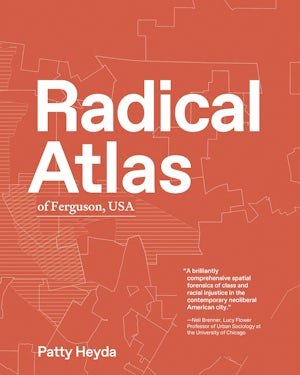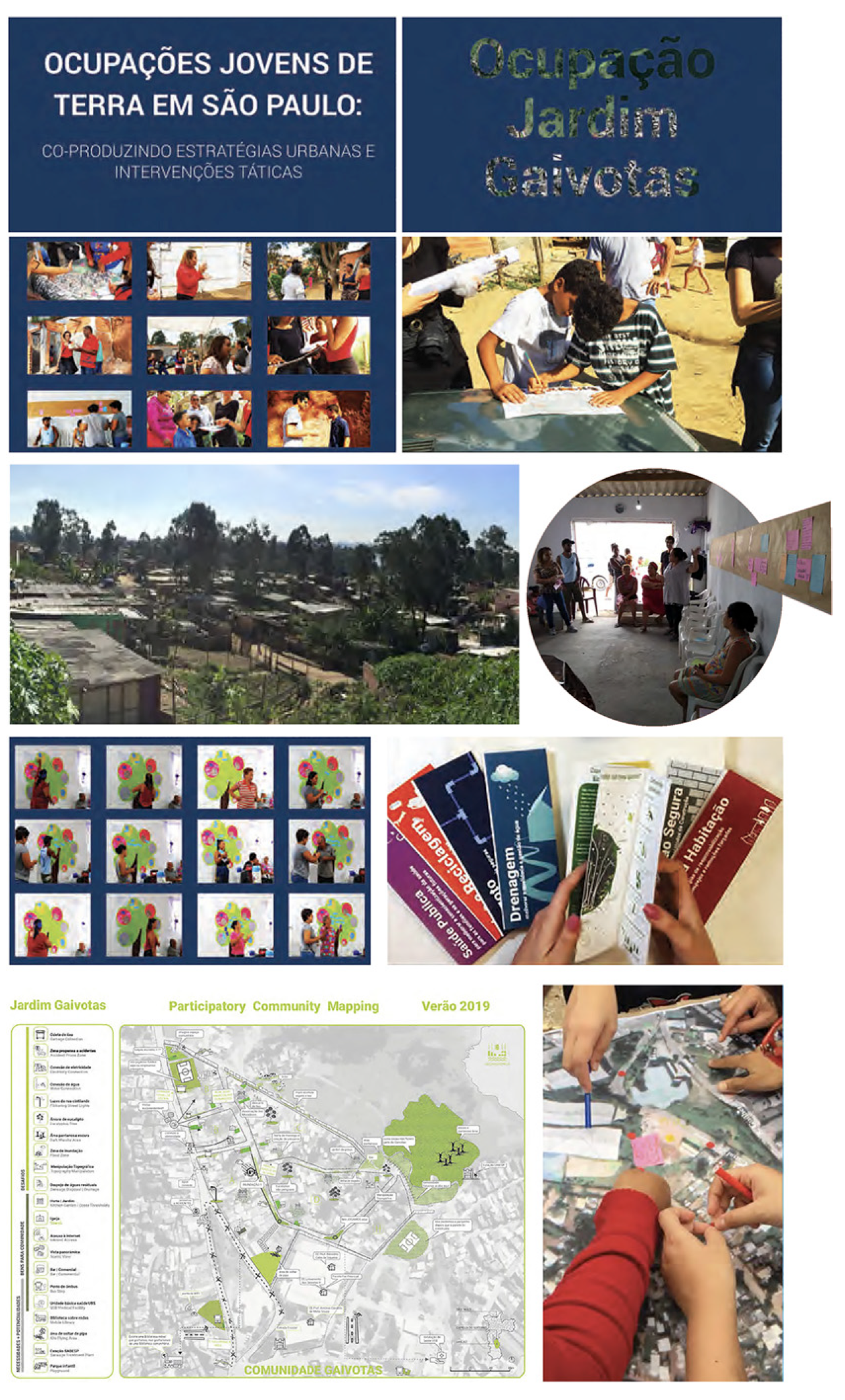PUBLICATIONS
RECENT Research FROM UDAC MEMBERS :
RADICAL ATLAS OF FERGUSON, USA
Patty Heyda
Ferguson, Missouri, became the epicenter of America’s racial tensions after the 2014 murder of Michael Brown and the protests that followed in its wake.
Though this suburb just outside St. Louis might have seemed like an average midwestern town, the activism that exploded there after Brown’s killing laid bare how longstanding municipal planning policies had led to racial segregation, fragmentation, poverty, and police targeting.
In over one hundred maps, Patty Heyda charts the systemic forces that have defined Ferguson, and the first-ring suburb in America more broadly. Through an in-depth look at the contradictions undergirding city planning and design,it illuminates how tax incentives, housing codes, urban design, policing, philanthropy, and even landscaping often work against the betterment of residents’ lives. At its heart lies a key question: Just who are our cities being built for?
A profound rethinking of what maps can be, Radical Atlas of Ferguson USA will challenge city planners, designers, and everyday citizens to change their perspective of public space.
Urban Manufacturing as a vehicle for Social and Environmental Justice
Julio Salcedo-Fernandez
The Case of North Brooklyn
The landscape of urban manufacturing in cities like New York is undergoing a profound transformation in the 21st century. The research delves into the intricate tapestry of urban manufacturing, focusing on the North Brooklyn Manufacturing Area, to illuminate initiatives fostering social and environmental justice. We explore the historical decline of manufacturing districts, their complex relationship with minority communities, and recent endeavors to reinvigorate urban manufacturing. These efforts aim to transform it into a source of economic opportunity for underserved communities and a potential hub for urban resource recovery (URR) programs within city limits to meet sustainability goals.
Salcedo-Fernandez, Julio. "Urban Manufacturing as a Vehicle for Social And Environmental Justice: The case of North Brooklyn". Urban Futures, Cultural Pasts. UCL Press, November 2024
Urban machines: PUBLIC SPACE IN A DIGITAL CULTURE
Marcella Del Signore Gernot Riether
At the beginning of the 21st century digital technology disrupted city life. The use of ICTs (information and communication technologies) has radically changed the way we inhabit and operate in the urban space. Over the last few decades an increasingly collaborative and interdisciplinary work developed by architects, artists, urban and media designers has defined a particular landscape of projects that engage information technology as a catalytic tool for expanding, augmenting and altering public and social interactions in the urban space. Through essays, case studies and conversations, this book aims to present a critical historical overview of the impact of information technologies on the physical public space while providing an inspiring vision of possible future scenarios for the public realm in a digital culture.
RADICAL MIDDLE GROUNDS
Martin Haettasch, ed. Dean Almy
From Crescent to Archipelago: Situational Housing on the Metropolitan Periphery
The twenty-fifth volume of the CENTER series explores housing beyond the established extremes of (suburban) house and (urban) apartment as an incubator for new forms of (co)habitation and urban morphology. Edited by Martin Hättasch, Radical Middle Grounds brings together architects and scholars to consider housing as a middle ground between unit and city, between form and process, and between enduring typology and design invention.
From Crescent to Archipelago: Situational Housing on the Metropolitan Periphery, authored by Dean Almy, is an investigation into the implications of massive population growth on the future of the Austin metropolitan area. Proceeding from the unique environmental ecology of the region, the research proposes a structural transformation from mono-centric to poly-centric city-region, strategizing a resilient future in the face of climate change.
Haettasch, M. ed., CENTER 25: Radical Middle Grounds: New Agendas for Medium Density Housing. The University of Texas at Austin, Center for American Architecture and Design, 2024
THE SUSTAINABLE URBAN DESIGN HANDBOOK
Nico Larco
Kaarin Knudson
The Sustainable Urban Design Handbook gathers the best sustainability practices and latest research from the fields of architecture, landscape architecture, planning, development, ecology, and environmental engineering and presents them in a graphically rich and accessible format that can help guide urban design decisions in cities of all sizes.
The book presents a comprehensive framework that organizes more than 50 elements of sustainable urban design under five main topics–Energy Use & Greenhouse Gas, Water, Ecology & Habitat, Energy Use & Production, and Equity & Health–and relative to four project scales: Region & City, District & Neighborhood, Block & Street, and Project & Parcel. Each element chapter includes a summary of importance and background, compares typical practices and recommended approaches, explains connections to other elements, and concludes with urban design guidelines that can be used to directly inform projects and decisions.
Easy to use and reference, The Sustainable Urban Design Handbook provides both an in-depth introduction to topics across sustainable urban design and serves as an on-going reference for anyone involved in the creation of sustainable urban environments. This resource will be useful to design and planning professionals, community members, students, and elected officials in guiding decisions about our sustainable future.
CASE STUDIES IN RETROFITTING SUBURBIA
Ellen Dunham-Jones
June Williamson
Urban Design Strategies for Urgent Challenges
Updated with a new Introduction by the authors and a foreword by Richard Florida, this book is a comprehensive guide book for urban designers, planners, architects, developers, environmentalists, and community leaders that illustrates how existing suburban developments can be redesigned into more urban and more sustainable places. While there has been considerable attention by practitioners and academics to development in urban cores and new neighborhoods on the periphery of cities, there has been little attention to the redesign and redevelopment of existing suburbs. The authors, both architects and noted experts on the subject, show how development in existing suburbs can absorb new growth and evolve in relation to changed demographic, technological, and economic conditions.
Retrofitting Suburbia was named winner in the Architecture & Urban Planning category of the 2009 American Publishers Awards for Professional and Scholarly Excellence (The PROSE Awards) awarded by The Professional and Scholarly Publishing (PSP) Division of the Association of American Publishers
NEXT NEW YORK
Mona El Khafif Seth McDowell
Over the last 500 years, a range of innovative, responsive, and pragmatic civic actions have helped to generate, define, and maintain New York City’s global significance. From early on much of these actions were responses to population density and the accompanying challenges for health and well-being. Approaching its next growth cycle, New York is again amid important urban transformations that demand new urban and architectural models that allow for an open city to balance gentrification, and to address a lack of public spaces, social infrastructure, and affordable housing. These challenges and their architectural and urban implications are the focus of Next New York.
The book captures the city’s current momentum through the lens of three important urban actions: sharing, connecting, and partnering. Through 10 essays from scholars and practitioners working on pressing urban issues, a photographic essay portraying New York during COVID-19, and more than 35 design projects from graduate studios at the University of Virginia’s School of Architecture, Next New York reflects, comments, and speculates on New York City’s capacity to bring about new conceptions of city-making and collective cohabitation through architecture.
PLANNING THEORY
María Arquero Del Alarcón
Activist Co-production for the Right to Occupy, Hold Ground, and Upgrade
Planning Theory, with colleagues Ana Paula Pimentel Walker, Abigail Friendly, Dito Barbosa, Mara Ribeiro de Souza, Sheila Nobre.
This article theorises a multi-year participatory action research engagement focusing on young land occupations and consolidated favelas in São Paulo’s south periphery, providing an arsenal of tools for activist-scholars. Building on Paulo Freire's legacy, we call on academia to embrace activist co-production, learn from and support informal dwellers’ everyday urbanisms, and join social movements’ struggles for social transformation. We advance three modalities of action: awareness raising through emancipatory education and capacity building; articulatção through knowledge exchange between young and consolidated informal communities; and advocacy through policy reform for the right to occupy, hold ground, and upgrade.
Special issue on ‘Coproducing the just city: Interrogating the civil society/academy interface.’
EXTREME URBANISM 2
Housing as a Form of Non-Formal Urbanism: Belapur Housing by Charles Correa, Navi Mumbai, 1983 to the Present
An overwhelming fascination, perhaps even an admiration for non-formal communities by architects and planners resides in a sense of their “authentic urbanity.” Authentic urbanity alludes to bottom-up planning that employs a highly sophisticated developmental process that often leads to a level of social interaction, plurality, equity, and spatial complexity to which other “planned” communities and urban design practices can only aspire. Charles Correa’s Belapur housing community, developed just outside Mumbai beginning in 1983, demonstrates several of his guiding urbanist principles, effectively achieving the urban authenticity that countless architects and planners admire in non-formal communities throughout the world. By practicing “architecture as a form of urbanism,” demonstrated through Correa’s example at Belapur, current urban designers might incorporate instrumental lessons or principles from non-formal development patterns into their more formal planning practices.
Calott, Christopher, published in Extreme Urbanism 2: Speculations and Alternative Futures for the Mumbai Metropolitan Region, Harvard University Press, Cambridge, Massachusetts, 2014.
Christopher Calott









